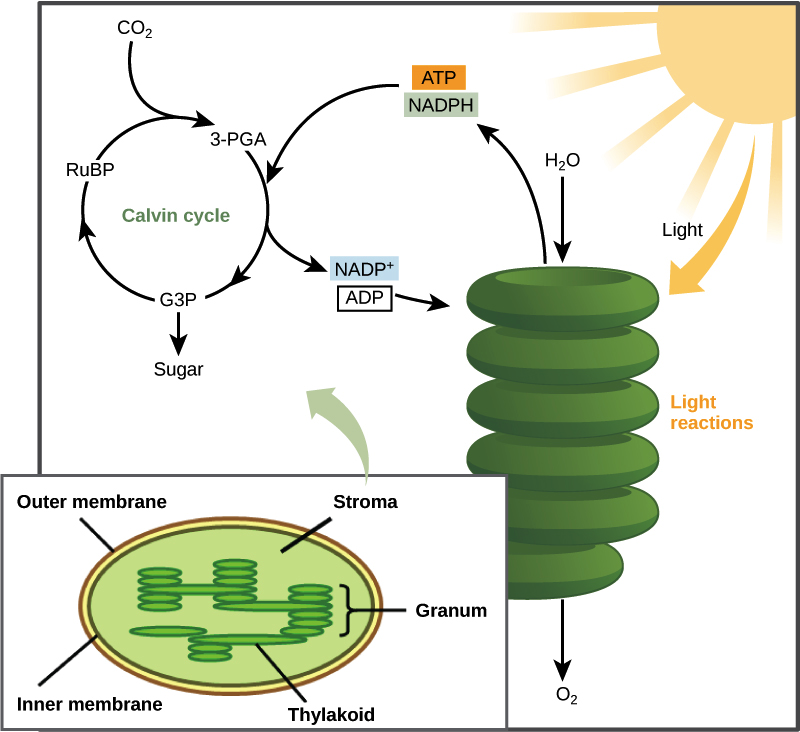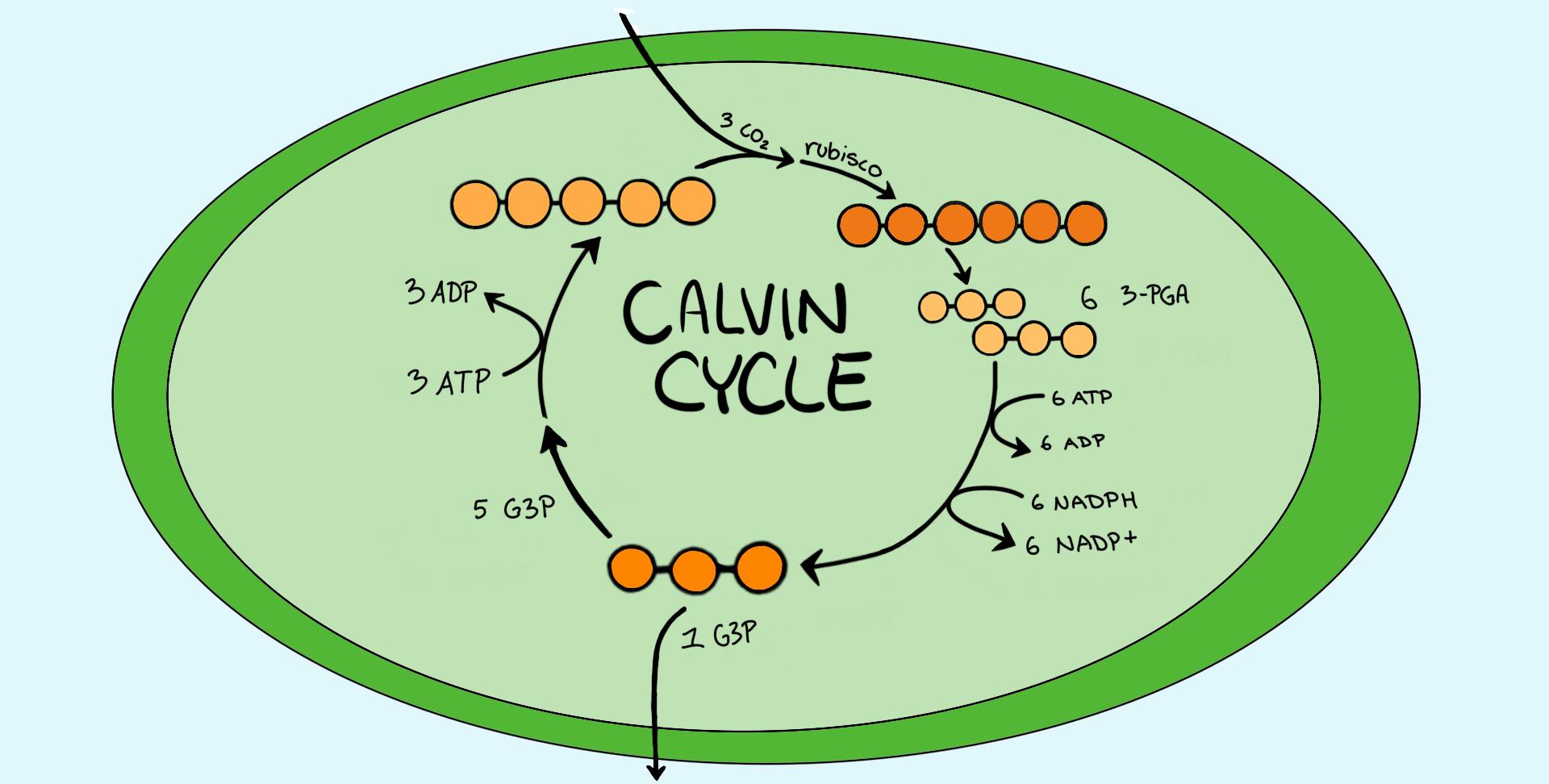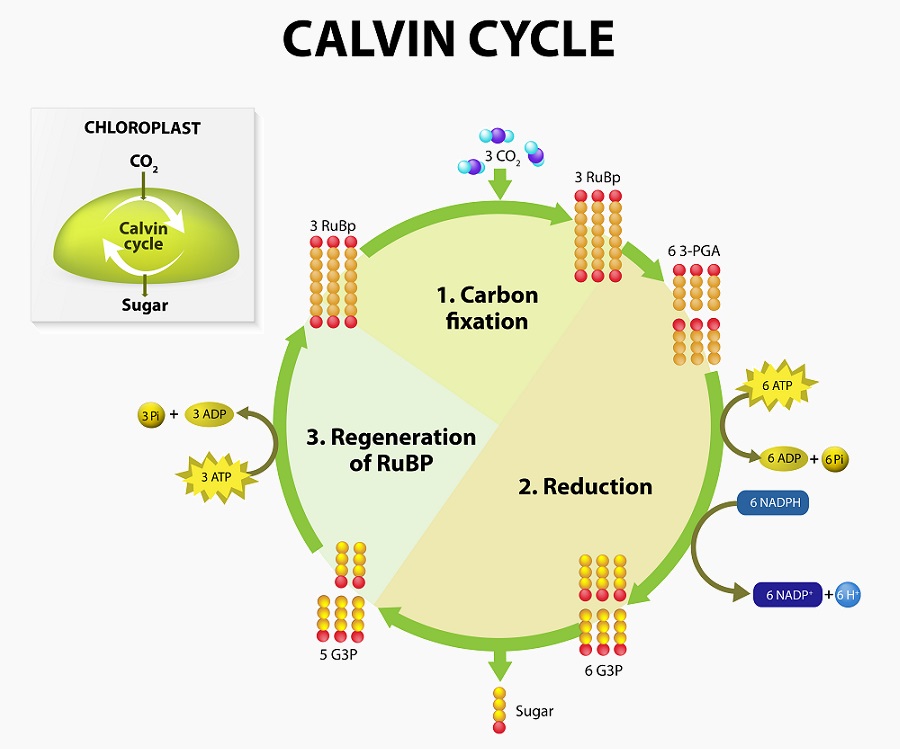Is the Calvin Cycle in the Stroma? This question lies at the heart of understanding photosynthesis, the process that sustains life on Earth. The Calvin Cycle, also known as the light-independent reactions, is a crucial stage of photosynthesis where the energy captured from sunlight is used to convert carbon dioxide into sugar. This remarkable process takes place within the chloroplast stroma, a fluid-filled region within the chloroplast that provides the necessary environment for the intricate reactions of the Calvin Cycle.
The stroma is a bustling hub of activity, teeming with enzymes and other molecules that orchestrate the Calvin Cycle’s complex steps. Imagine it as a well-equipped workshop, where each component plays a vital role in the assembly of sugars from carbon dioxide. The stroma’s unique composition and structure, rich in essential nutrients and enzymes, create the perfect setting for the Calvin Cycle to flourish.
The Calvin Cycle
Photosynthesis is the process by which plants, algae, and some bacteria use sunlight, water, and carbon dioxide to produce their own food in the form of glucose. This process is crucial for life on Earth as it is the primary source of energy for most ecosystems.
The Calvin cycle, named after its discoverer Melvin Calvin, is a series of biochemical reactions that take place in the stroma of chloroplasts. It is the second stage of photosynthesis, following the light-dependent reactions, and is responsible for converting carbon dioxide into sugar. This process is essential for the production of glucose, which serves as the primary energy source for plants and ultimately for all living organisms.
The Stroma: Location of the Calvin Cycle
The stroma is the fluid-filled space within the chloroplast that surrounds the thylakoid membranes. It is a complex environment containing various enzymes, including those responsible for the Calvin cycle reactions. The stroma is also where the products of the light-dependent reactions, ATP and NADPH, are used to drive the Calvin cycle.
The Stroma

The chloroplast stroma, a viscous fluid-filled region, is the site of the Calvin cycle, a crucial process in photosynthesis. It’s a dynamic environment teeming with enzymes, molecules, and structures that work together to convert carbon dioxide into sugars.
The Stroma’s Structure and Composition
The stroma is a complex mixture of proteins, enzymes, and other molecules dissolved in water. It’s enclosed by the inner membrane of the chloroplast, which separates it from the thylakoid membrane system. The stroma’s structure is essential for its function, providing a suitable environment for the Calvin cycle to occur.
The Stroma’s Role in Facilitating the Calvin Cycle
The stroma provides the necessary environment for the Calvin cycle by:
- Maintaining a suitable pH and ionic strength for the enzymes involved in the Calvin cycle to function optimally.
- Providing a concentrated pool of essential molecules, such as ATP and NADPH, generated during the light-dependent reactions of photosynthesis, which are required as energy sources for the Calvin cycle.
- Serving as a platform for the assembly and organization of the Calvin cycle enzymes, facilitating efficient and coordinated reactions.
Enzymes and Molecules in the Stroma, Is the calvin cycle in the stroma
The stroma contains numerous enzymes and molecules that are essential for the Calvin cycle. Some of these key players include:
- Rubisco: This enzyme catalyzes the initial step of the Calvin cycle, the fixation of carbon dioxide into an organic molecule.
- Ribulose bisphosphate carboxylase/oxygenase (RuBisCO): This enzyme is responsible for the first step of the Calvin cycle, the fixation of carbon dioxide into an organic molecule.
- Phosphoribulokinase (PRK): This enzyme catalyzes the phosphorylation of ribulose 5-phosphate, a key intermediate in the Calvin cycle.
- Glyceraldehyde 3-phosphate dehydrogenase (GAPDH): This enzyme is involved in the reduction of 1,3-bisphosphoglycerate to glyceraldehyde 3-phosphate, a crucial step in the Calvin cycle.
- Triose phosphate isomerase (TPI): This enzyme interconverts dihydroxyacetone phosphate and glyceraldehyde 3-phosphate, ensuring a continuous flow of intermediates in the Calvin cycle.
These enzymes work in concert to carry out the complex series of reactions that make up the Calvin cycle, ultimately converting carbon dioxide into glucose, the primary energy source for plants and other organisms.
Steps of the Calvin Cycle

The Calvin cycle, named after its discoverer Melvin Calvin, is a series of biochemical reactions that occur in the stroma of chloroplasts during photosynthesis. This cycle utilizes the energy stored in ATP and NADPH, produced during the light-dependent reactions, to convert carbon dioxide into glucose, the primary source of energy for the plant. The Calvin cycle is divided into three main stages: carbon fixation, reduction, and regeneration.
Carbon Fixation
Carbon fixation is the initial step in the Calvin cycle where carbon dioxide from the atmosphere is incorporated into an organic molecule. This crucial step is catalyzed by the enzyme RuBisCo (ribulose-1,5-bisphosphate carboxylase/oxygenase), which binds carbon dioxide to a five-carbon sugar called ribulose-1,5-bisphosphate (RuBP). The resulting six-carbon compound is unstable and immediately breaks down into two molecules of 3-phosphoglycerate (3-PGA), a three-carbon compound.
RuBP + CO2 → (unstable six-carbon compound) → 2 3-PGA
RuBisCo is a complex enzyme that plays a vital role in photosynthesis. It is responsible for fixing carbon dioxide, making it the most abundant protein on Earth. The significance of RuBisCo lies in its ability to catalyze the first step of carbon fixation, a process that is essential for life on Earth.
Reduction
In the reduction stage, 3-PGA is converted into glyceraldehyde-3-phosphate (G3P), a three-carbon sugar. This process requires energy from ATP and reducing power from NADPH, both produced during the light-dependent reactions. The reduction reaction involves two key steps:
- Phosphorylation: 3-PGA is phosphorylated by ATP to form 1,3-bisphosphoglycerate (1,3-BPG). This reaction adds a phosphate group to 3-PGA, making it more reactive.
- Reduction: 1,3-BPG is reduced by NADPH to form G3P. This reaction removes a phosphate group and adds two electrons, reducing the molecule and storing energy.
Regeneration
The final stage of the Calvin cycle involves regenerating RuBP, the starting molecule for carbon fixation. This process requires energy from ATP and involves a series of complex reactions that rearrange carbon atoms. The regeneration of RuBP ensures the cycle can continue, allowing for the continuous fixation of carbon dioxide.
- Rearrangement: G3P molecules are rearranged and combined to form various intermediate compounds.
- Phosphorylation: ATP is used to phosphorylate these intermediates, leading to the formation of RuBP.
Products of the Calvin Cycle
The Calvin cycle, a critical part of photosynthesis, not only produces the vital sugar glucose but also serves as a foundation for synthesizing various other essential molecules that drive plant growth and development. This process, occurring within the stroma of chloroplasts, is a symphony of biochemical reactions, ultimately leading to the creation of building blocks for life.
Glucose: The Primary Product
Glucose, a simple sugar, is the primary product of the Calvin cycle. This six-carbon molecule is the fuel that powers plant cells, providing energy for growth, reproduction, and other essential processes. Glucose is also the building block for more complex carbohydrates, such as starch, which plants use for energy storage.
The Calvin cycle, through a series of enzymatic reactions, converts carbon dioxide from the atmosphere into glucose.
Other Essential Molecules
The Calvin cycle’s versatility extends beyond glucose production. It also serves as a source for the synthesis of other vital molecules, including amino acids and lipids.
Amino Acids
Amino acids, the building blocks of proteins, are essential for various cellular functions, including enzyme production, structural support, and defense mechanisms. The Calvin cycle provides the necessary carbon skeletons for the synthesis of amino acids.
Lipids
Lipids, including fats and oils, play crucial roles in energy storage, membrane structure, and hormone production. The Calvin cycle contributes to the synthesis of lipids by providing the carbon skeletons needed for their formation.
Regulation of the Calvin Cycle: Is The Calvin Cycle In The Stroma

The Calvin cycle, the central metabolic pathway of photosynthesis, is not a static process but a dynamic one, finely tuned to respond to the ever-changing environmental conditions. Its regulation ensures efficient carbon fixation and energy utilization, maximizing the plant’s ability to thrive.The Calvin cycle’s rate is influenced by a multitude of factors, including light intensity, CO2 concentration, and temperature, all of which act as signals for the plant to adjust its metabolic activities.
These factors work in concert to modulate the activity of key enzymes involved in the cycle, ultimately controlling the rate of carbon fixation.
Feedback Mechanisms in the Calvin Cycle
Feedback mechanisms play a crucial role in maintaining the balance of the Calvin cycle. The cycle’s products, like sugars and starch, can act as feedback inhibitors, slowing down the cycle when their levels are high. Conversely, when these products are depleted, the cycle speeds up to replenish them. This intricate feedback loop ensures that the cycle operates at an optimal rate, preventing excessive accumulation or depletion of its products.
Integration with Other Metabolic Pathways
The Calvin cycle is not an isolated process but is intricately integrated with other metabolic pathways in the plant cell. The products of the cycle, like sugars, serve as substrates for various pathways, including respiration, biosynthesis, and growth. The cycle also receives inputs from other pathways, such as ATP and NADPH generated during the light-dependent reactions of photosynthesis. This interconnectedness ensures that the plant’s metabolic machinery functions efficiently and harmoniously, maximizing resource utilization and supporting overall growth and development.
Importance of the Calvin Cycle
The Calvin cycle, a vital metabolic pathway within chloroplasts, is a cornerstone of life on Earth. It serves as the foundation for the production of organic compounds, which are essential for sustaining all life forms. The Calvin cycle’s significance lies in its ability to capture and convert inorganic carbon dioxide into organic sugars, fueling the growth and development of plants and indirectly supporting the entire food chain.
The Calvin Cycle’s Role in Global Carbon Cycling
The Calvin cycle plays a pivotal role in the global carbon cycle, a complex system that governs the movement of carbon atoms through the Earth’s atmosphere, oceans, and living organisms. The cycle begins with the absorption of carbon dioxide from the atmosphere by plants during photosynthesis. Within the chloroplasts, the Calvin cycle utilizes this captured carbon dioxide to synthesize glucose, a simple sugar that serves as the primary energy source for plants and, consequently, for all heterotrophic organisms.
This process effectively removes carbon dioxide from the atmosphere, mitigating the effects of climate change.
The Calvin Cycle’s Contribution to Food Production and Essential Resources
The Calvin cycle is directly responsible for the production of food and other essential resources. Plants, through the Calvin cycle, convert light energy into chemical energy stored in the form of glucose. This glucose is then used to build complex carbohydrates, proteins, lipids, and other vital molecules that are essential for plant growth and development. Humans and other animals rely on plants as their primary source of food, ultimately deriving their energy and building blocks from the products of the Calvin cycle.
The Calvin cycle is a fundamental process that sustains life on Earth, providing the basis for food production, global carbon cycling, and the synthesis of essential resources.
The Calvin Cycle, nestled within the chloroplast stroma, is a testament to the elegance and efficiency of nature’s design. It’s a captivating dance of molecules, where energy from sunlight is transformed into the building blocks of life. By understanding the intricacies of the Calvin Cycle, we gain a deeper appreciation for the fundamental processes that sustain our planet and its diverse ecosystems.
Query Resolution
What is the role of RuBisCo in the Calvin Cycle?
RuBisCo, or ribulose-1,5-bisphosphate carboxylase/oxygenase, is a key enzyme in the Calvin Cycle. It catalyzes the first step of carbon fixation, where carbon dioxide is incorporated into an organic molecule. RuBisCo is essential for converting atmospheric carbon dioxide into usable organic compounds, driving the process of photosynthesis.
How does the Calvin Cycle contribute to plant growth and development?
The primary product of the Calvin Cycle is glucose, a simple sugar that serves as the fundamental building block for plant growth. Glucose is used to produce other essential molecules like cellulose, which forms the plant’s structural framework, and starch, a storage form of energy. The Calvin Cycle also produces amino acids, the building blocks of proteins, and lipids, important components of cell membranes.
What factors regulate the Calvin Cycle?
The Calvin Cycle is tightly regulated by various factors, including light intensity, carbon dioxide concentration, and temperature. Light intensity directly influences the rate of photosynthesis, while carbon dioxide concentration provides the necessary substrate for the cycle. Temperature affects the activity of enzymes involved in the Calvin Cycle. Feedback mechanisms also play a role in controlling the rate of the cycle, ensuring that it operates efficiently and effectively.




:max_bytes(150000):strip_icc()/infection-5096014-Final-eaf7a90b39fd4eb69b3a1776b721d975.gif?w=700)

Storm
What Did Bob Brenly Say About Stroman?